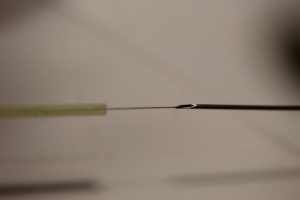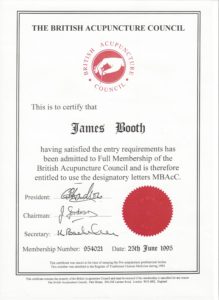Q. Are needles painful?
A. People’s sensitivity and reaction to pain varies enormously so this is a hard question to answer! The style of Japanese acupuncture that I practise uses very fine needles, between 1/10 and 1/5mm in diameter and are way finer than the hypodermics used for injections or blood tests (see photo), with a correspondingly reduced sensation. Because of this the vast majority of patients comment that the diagnostic palpation which comes before treatment is actually more uncomfortable than any needle. In addition strong needle sensation is usually contra-indicated, in other words it might actually hinder the treatment, and I usually remove or re-position a painful needle. For really sensitive people we use the finest needles, magnets, or other non-invasive techniques which are based on warming the points or rhythmically tapping them. These stimulate the acupuncture points without the use of needles.

Q. Are needles safe and is there a risk of infection from them?
A. All needles used in acupuncture are single use, pre-sterilised, and they are disposed of after use. In over 25 years of practice I haven’t heard of a case of infection, and no patient has ever reported this to me. Very occasionally in sensitive people there is a very small local reaction to needles which will typically disappear in a few minutes. Of course if you are allergic to stainless steel you should let me know! The needles are very fine and are also made from surgical grade steel, so are very strong and flexible.
Q. What is moxibustion?
A. This is the use of various dried forms of the herb Artemisia vulgaris (this is ‘mogusa’ in Japanese = moxa or common mugwort). It is used to warm the acupoints. In this style of acupuncture it is sometimes burnt indirectly on top of needles, and sometimes directly on the surface of the skin using a ‘thread’ of pure moxa. Hence moxibustion. The practice is mentioned in the oldest extent text on Chinese medicine (it is the only treatment modality mentioned) and has always been used side-by-side with needles although in Japan some practitioners use moxibustion almost exclusively. By the way the Japanese word is derived from two words meaning ‘burn’ and ‘grass’.
Q. How many treatments will I need?
A. The number of appointments you will need varies from person to person. This is because people come with widely different conditions and in varying states of health, while some conditions are inherently more difficult to treat. As a guide i see patients once a week for a month and then less frequently as their health improves.
Q. Should i tell my GP?
A. If you are receiving treatment from your doctor it makes sense to tell them of your plans to have acupuncture. The acupuncture treatment may enable you to reduce some forms of medication but ALWAYS consult your doctor about any change of prescription. Likewise inform your acupuncturist about any medication or drugs that you are taking as it may affect your response to treatment or the treatment may alter the effect of the drugs.
 Q. What are your qualifications?
Q. What are your qualifications?
A. Having studied with two Japanese masters while in Tokyo for 2 years, I returned to the UK in 1989 and trained full-time at two acupuncture schools in the UK from 1989-1992. I then joined the Register of Traditional Chinese Medicine becoming a founder member of the British Acupuncture Council in 1992. I have been practising Japanese acupuncture since 2003.